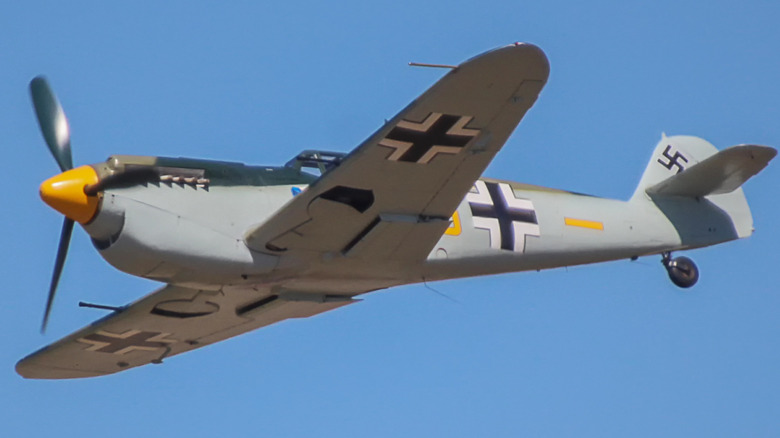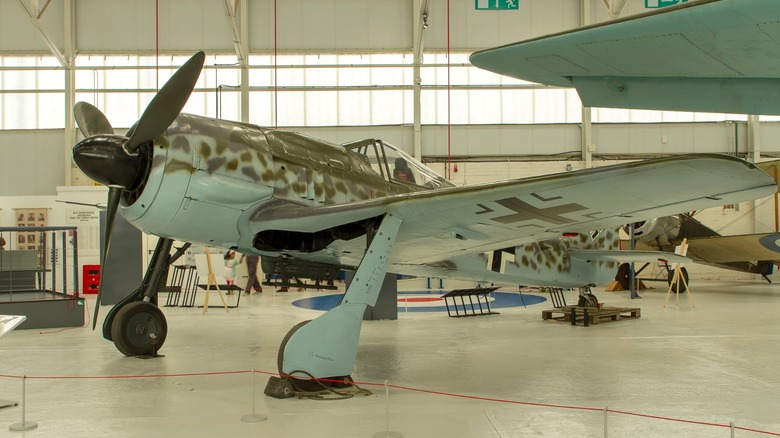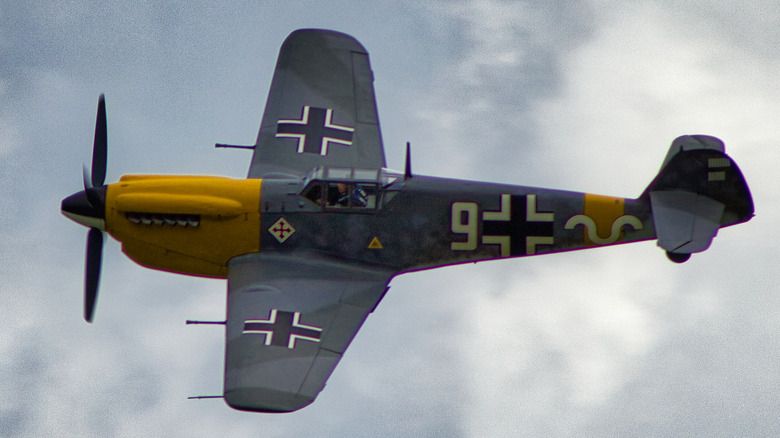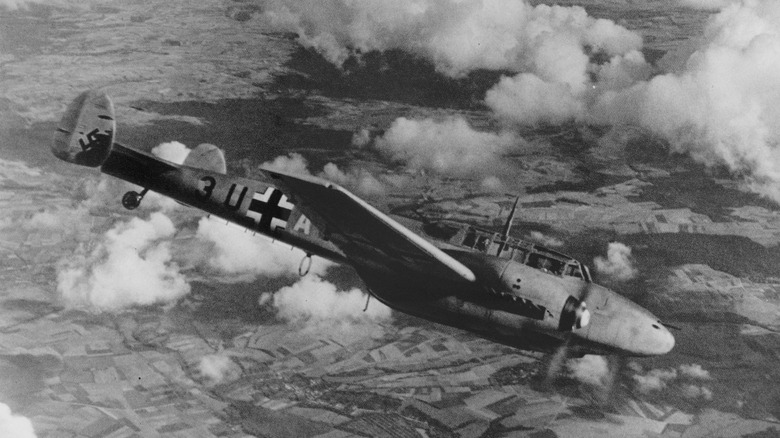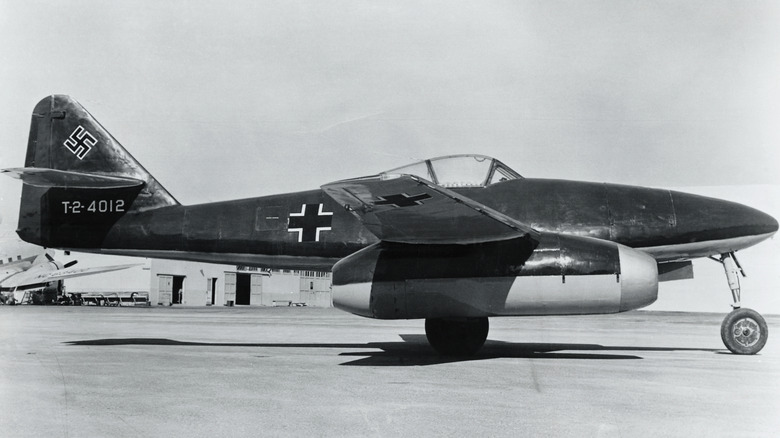4 Of The Best German Fighter Planes Of WW2
German engineers and scientists created some exceptional and novel military designs during WWII. Granted, not everything they created was an instant success, and they even created one fighter jet that was destined to fail, but German aeronautical ingenuity at the time gave Allied forces a run for their money. Until the United States sent the P-51 Mustang to Europe in 1943, the Luftwaffe claimed air superiority in most parts of Europe.
The theaters of World War II were swarming with notable aircraft, but Germany really tested some limits. The country started using electrically powered landing gears, moving away from conventional practices. Then there was its first operational fighter with a turbojet engine, which England was also trying to develop at the time too, that had a moment to shine before Allied forces found its weakness and exploited it until it was as useful as a paperweight on a battlefield.
Germany produced a plethora of planes throughout the war, from bombers to fighters, and they were always exploring new engineering techniques. These four stand out as the best the Third Reich had to offer.
Focke-Wulf Fw190
The Focke-Wulf Fw190 had the affectionate name, the Würger — or the Butcher Bird – which is fitting, as it was commonly used to butcher unescorted American bombers. While the B-17 helped win World War II and could defend itself with its 13 machine gun placements, they weren't nearly as agile as smaller fighter planes and were vulnerable without escort planes. This single-seat, single-engine plane entered service for the Luftwaffe in 1941 and flew on all fronts of the war. It was an innovative plane, as it was the first and only aircraft in the war to have both electrically operated landing gears and flaps. Moreover, it was the only German fighter to use a radial engine.
It was a BMW 139 fourteen-cylinder, air-cooled, radial engine that performed well but struggled with high temperatures. However, in the summer of 1941, when Fw190 pilots went up against a squadron of Spitfires – one of the most innovative planes of WWII – the Butcher Bird proved itself to be superior by most measures. To solve the overheating issue with the plane, Germany moved the engine six inches forward on the A-5 iteration of the plane.
When the US and its allies started producing planes like the P-51 Mustang, Germany worked to improve on the Fw190 A design. A couple of prototypes resulted in the Fw190 D. This version — built with a liquid-cooled Junkers Jumo 213 engine –was a superb fighter but wasn't delivered until 1944, too late to compensate for Germany's fuel shortage and lack of experienced pilots.
Messerschmitt Bf 109 was the plane to fear
The backbone of the Luftwaffe's air superiority rested with the Messerschmitt Bf 109, a single-engine fighter plane that saw combat from the start of the war in 1936 until the bitter end in 1945. It underwent regular modifications throughout its life: Series A through D had a Junkers Jumo 210 engine under the hood that produced 675 horsepower, while the E and F series were built with the more powerful Daimler-Benz DB 601, producing 1085 hp. However, the G series, the most numerous of all iterations of the Bf 109, had a Daimler-Benz DB 605 engine that kicked out a stunning 1,455 horsepower.
Mention the Bf 109 to any aviation buff, and they know exactly which plane you're talking about. Germany produced 33,984 airframes, making it one of the most produced fighter planes in history, second only to the Soviet Ilyushin IL-2. Germany even sent the plane to a few of its allies, including Italy and Hungary. Switzerland bought a few in the late 1930s and even used them to shoot down German pilots when they crossed into Swiss airspace. Armed with a 30mm MK 108 cannon and two 13mm MG 131 machine guns, no other plane in WWII stacked up as many aerial kills as the Bf 109.
The Messerschmitt Bf 109 was no match for the P-51 Mustang once it entered the war, however. Not only could the Mustang outperform the Bf 109 in agility, but it also had better fuel economy, being able to escort bombers to their targets and back to base.
Messerschmitt Bf 110
The Messerschmitt Bf 110 came about from Germany's desire to have a long-range fighter that could also drop bombs when necessary. German engineers came up with a highly effective twin-engine fighter that functioned just as well on offensive missions as it did on defensive ones. Unfortunately for the Luftwaffe, the British had its number during daytime missions. In response the Bf 110 was equipped with radar — making it a successful night fighter.
It was supposed to receive a powerful DB 600-series engine, but continuous issues forced engineers to use twin Junkers Jumo 210s initially, giving it a top speed of 268 mph. By 1938, Germany was able to use the Daimler-Benz DB 601-A1, which featured direct fuel injection, and were able to get the plane up to 336 mph. The feature that set the Bf 110 apart from other fighters were the hardpoints to which bombs could be attached.
In terms of guns, it was armed with four 7.92mm MG 17 machine guns in the nose of the plane, handling anything in front of it. Additionally, it had protection in the rear with a single 7.92mm MG 15 machine gun mounted at the rear of the cockpit. The Germans believed the Bf 110 could be used to break through enemy fighter defenses because of its armament. Around 6,170 Bf 110s were produced before it was retired in 1945.
Messerschmitt Me 262 Schwalbe
The world's first functional fighter jet saw its fair share of action during the latter end of World War II, when Allied nations started using the likes of P-51 Mustangs and P-47 Thunderbolts, which outperformed many conventional German combat planes. The Messerschmitt Me 262 gave the Luftwaffe a small advantage. This new fighter jet relied on speed more than maneuverability, targeting bombers with four 30mm MK-108 cannons and using their superior speed to escape escort planes.
Its two Junkers Jumo 004 engines, each capable of 1,980 lbs. of thrust, gave it a maximum speed of 540 mph, considerably fast compared to conventional fighter planes. There were plenty of delays in developing the turbojet engines, so even though it was based on an idea from 1938, it didn't even enter the war until 1944. Its first mission saw an Me 262 attack a British reconnaissance aircraft over Munich. In addition to its four cannons, it could carry up to 1,200 lbs. of bombs or rockets.
Despite the Me 262 having the upper hand in the air, it was vulnerable during takeoffs and landings because their engines couldn't get to full power quickly enough. Instead of going head-to-head against the Me 262, Allied forces started targeting them when they returned to base to refuel and rearm. Bombers were often sent on missions to bomb the bases that housed the Me 262, destroying hundreds of them before they could claim air superiority.
